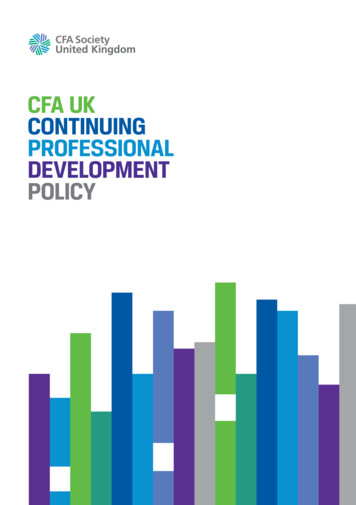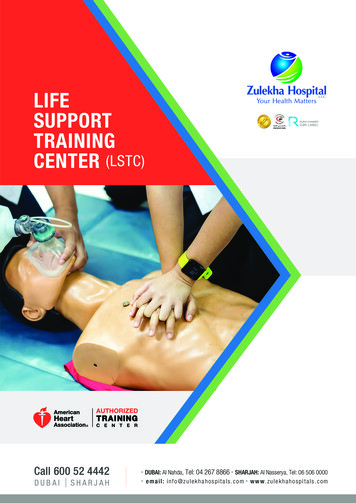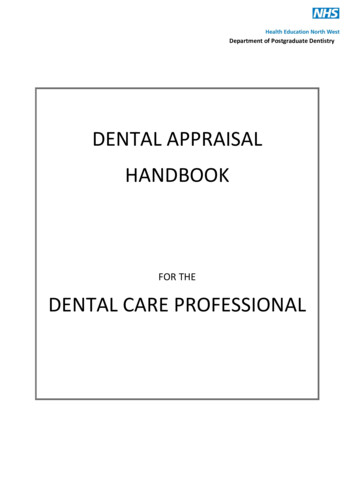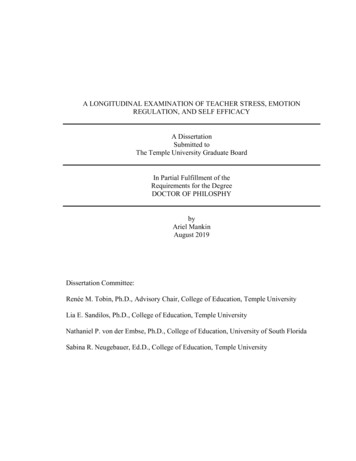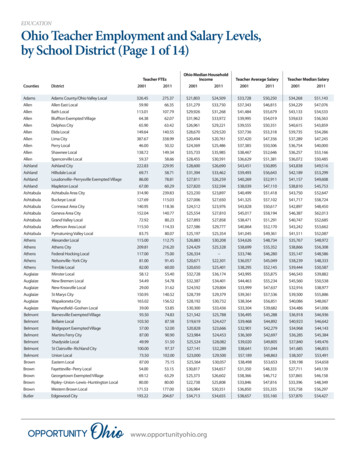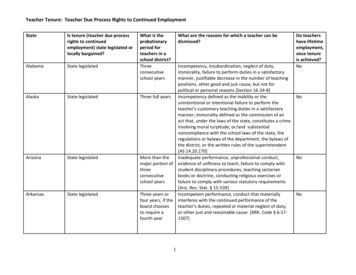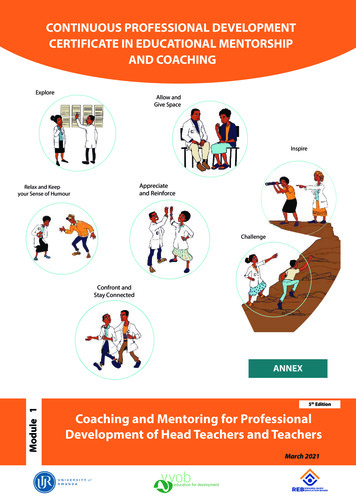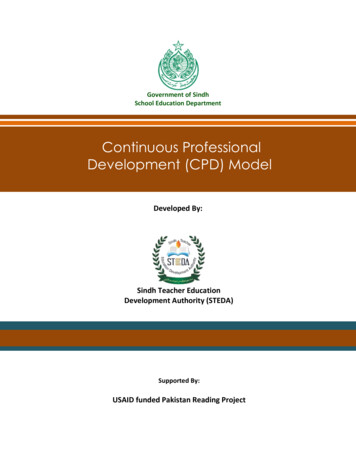
Transcription
TEACHER CPDInternational trends,opportunities and challengesEdited by Cat Scuttand Sarah Harrison,Chartered College of TeachingSupported by a grantfrom Nord Anglia Education
Teacher CPD: International trends, opportunities and challengesAbout Chartered College of TeachingThe Chartered College of Teaching is the professional body forteachers. They are working to celebrate, support and connectteachers to take pride in their profession and provide the bestpossible education for children and young people. They arededicated to bridging the gap between practice and researchand equipping teachers from the second they enter the classroomwith the knowledge and confidence to make the best decisionsfor their pupils.About Nord Anglia EducationNord Anglia is a global family of 66 premium internationalschools, based in 29 countries around the world. We offerpersonalised, inspiring learning to more than 64,000 studentsbetween 2 and 18 years old. Chartered College of Teaching, 2019. Views expressed in this report arenot necessarily those of the Chartered College of Teaching.9-11 Endsleigh Gardens, London, WC1H 0EH, United Kingdomchartered.collegehello@chartered.college02
ForewordForewordI am delighted to introduce this visionary project by the Chartered College ofTeaching bringing together, as it does, some of the best thinkers in the fieldof professional learning, along with case studies of how to bring it about inpractice.Nord Anglia Education has been very pleased to support the development of thispublication as it mirrors entirely our own philosophy, that professional learning isonly as good as the impact that it has on teachers and ultimately students in ourclassrooms, laboratories, playing fields and studios. This is an area that several of thepieces explore in much more detail, and which I will commend to all my colleagues.In nearly 30 years in UK state teaching and school leadership, and now six years inthe international sector, I have been privileged to discover some universal principlesthat underpin great professional learning, and these are reflected exceptionally wellin all these pages. It is at its best when it is part of a virtuous cycle that encompassesperformance review and development (let’s hope we can quickly lose the, in myopinion, outdated concept of performance ‘management’), feedback, identificationof learning goals and true involvement of our colleagues in identifying their ownneeds. The philosophy espoused in this publication is that of professional learningconversations, mentoring, coaching and guidance, without losing any of the rigour thatis an essential part of maintaining the highest standards of professional practice.When I was a headteacher in a UK state comprehensive, not that long ago, thegreatest compliment I ever received was when a colleague reflected that togetherwe had created a true learning organisation, where every member of our communityactively sought out opportunities for personal and professional development andreceived the right level of support. It has always saddened me when I see schools(and have of course faced the same temptations myself) seeking to balance budgetsby shaving their professional development allocations – we all know that it is shortsighted to do so and of course we are all aware of the pressures. However, readingthese pages has inspired me once again to maintain our organisation’s consistentand unflinching commitment to providing the best experience possible for everycolleague, be they teaching staff or part of our wider team.I hope it will equally challenge and inspire all those who read the various articles,reviews, research reports and case studies and I look forward to developing this mostimportant of conversations more and more deeply in the future.Andy Puttock, Group Education Director, Nord Anglia Education, UK03
Teacher CPD: International trends, opportunities and challengesContentsForeword03Introduction from the editors0601Measuring teaching quality:How, why and for whom?10Evaluating and measuring teaching quality15The role of advanced teacher certification inpromoting quality teaching and lifting the statusof the teaching profession2327CJ Rauch and Rob CoeLawrence IngvarsonCase study: The National Board Certificationprocess as a school improvement strategyAnn Jacquith, Jon Snyder and Travis J BristolCase study: The Chartered College of Teaching’sChartered Teacher ProgrammeNick Gray0203The role of professionalculture in teacher developmentDesigning and measuringeffective teacher development3260Professional development: Evidence of what works68Extended case study: Perspectives and evidenceon effective CPD from Canada3542445255Developing workplaces where teachers stay,improve and succeedJohn P Papay and Matthew A KraftUnderstanding teaching as a professionJosephine Booth, Emily Perry and Mark BoylanCase study: The Wellcome CPD ChallengeNan DaviesExtended case study: Forging the links betweenteaching quality, professional collaboration andorganisational ambidexterity in three schools inHong KongJames KoCase study: Lessons from Australia and New Zealand7884Katy TheobaldCase study: The Chartered College of Teaching:Building a strong professional culture at every levelof the systemAlison Peacock047586David Weston and Bethan HindleyCarol CampbellCase study: Sustained professional development toenhance assessment practiceJamie ScottIdentifying evidence-based professional development:programmes, forms and mechanismsSam Sims and Harry Fletcher-WoodCase study: Promoting and facilitating professionallearning across an international school group throughNord Anglia UniversityAndy PuttockQuality assurance in teacher professionaldevelopmentEmily Perry, Mark Boylan and Josephine Booth
Table of Contents04Mentoring, coaching and deliberate practice96104107112118121Coaching and mentoring for teacher development:An overview of research and practiceSarah HarrisonCase study: Using specialist coaching toenhance teachers’ knowledge from speechand language sciencesRachel Lofthouse, Jo Flanagan and Bibiana WigleyPrincipled induction and mentoring of new teachers125127133Frances Langdon, Caroline Daly, EmmajaneMilton, Ken Jones and Melanie PalmerCase study: Transforming teaching througha coaching cultureEmily HendersonThe need for practice in teaching:Could simulations be the answer?Cat ScuttCase study: Instructional Coaching within theEducation Development Trust and Chartered College‘Accelerate’ programmeKaty ChedzeyImproving teachers’ instructional practice:Critically important, but incredibly hard to doBecky AllenCase Study: National Tablets Programme, Kenya –improving the coaching provided to teachersTony McAleavy, Alex Hall-Chen, SarahHorrocks and Anna RiggallHow do we learn how to do something?The role of deliberate practiceBen Riley0506Collaboration, subject expertiseand research engagementTechnology for ative engagement in and with research:a central part of the CPD landscapePhilippa CordingleyCase study: The East Sussex Early Years ImprovementTeam’s ‘Interacting with babies’ collaborativeresearch projectLaura PiperWhat does great subject-specific professionaldevelopment look like?Philippa Cordingley and Toby GreanyLesson study: The Japanese approach to teacherprofessional developmentBen Jensen, Katie Roberts-Hull, JacquelineMagee and Leah GinnivanExtended case study: Teachers’ analysesof educational research as a source ofprofessional developmentDavid C BerlinerCase study: Embedding Formative Assessment176179187190192Harnessing the power of technology to supportprofessional learningAnna Riggall and Tony McAleavyCase study: Anyone, anytime, anywhere: UsingMOOCs to support teacher educationAmy IckeExtended case study: Knowledge sharing throughdigital toolsJon Audain, Marilyn Leask, Christina Preston,Richard Procter and Sarah YounieSocial media and reflective practice – a world-widesupport networkGemma JacksonCase study: Professional learning through a dailyonline survey platformLaura McInerneyCase study: The Chartered College of Teaching’sonline Early Career Support programmeHannah TyremanSiobhan Leahy and Dylan WiliamCase study: Helping teachers overcome barriersto research engagementLisa-Maria Müller05
Teacher CPD: International trends, opportunities and challengesIntroductionfrom the editorsWhen we first developed the idea for this publication, we envisaged a short report,comprising a small number of articles highlighting some key research and practicein teacher CPD from around the globe. And yet, as we began to identify topics andthemes and to seek contributions, we found that the quality and variety of approachesand thinking that is happening in teacher professional development internationallydeserved more – leading to a collection of over 30 articles, case studies and summariesthat we hope showcases some of the trends, opportunities and challenges indeveloping and enacting powerful professional learning for teachers. Within thesepages, some of the world’s leading researchers and practitioners share their ownperspectives, projects and reflections around teacher CPD, and we see some of theseprinciples in action through case studies from a range of different schools and settings.We know the impact that high-quality teaching has on the learning of children and youngpeople (Sutton Trust, 2011), and we know, too, the impact that professional developmentcan have on teacher effectiveness (Cordingley et al., 2015). The publication starts, therefore,with a section exploring how (and indeed if) it might be possible or desirable to assessteacher effectiveness. From CJ Rauch and Rob Coe’s exploration of possible approaches tomeasurement to Lawrence Ingvarson’s articulation of the importance of teacher certification,this section underpins all of the articles that follow, recognising as it does that theeffectiveness of professional learning itself is predicated on its impact on practitioners, and,ultimately, pupil outcomes.Of course, no matter how well-designed and implemented, teacher CPD is only likely to bearfruits in an environment and culture where it is prioritised by leadership (Department forEducation, 2016) and where teachers feel supported to take action based on their learning.The second section therefore moves to the wider topic of professional culture, how this canbe developed, and the role it plays in supporting teacher development. Matthew Kraft andJohn Papay outline the features of schools where teachers continue to become more effectiveover time, Emily Perry and colleagues look more widely at notions of teacher professionalism,and we see case studies from Hong Kong, New Zealand, Australia and England.Building on these key ideas, the third section reflects on what we know about effectiveprofessional learning (and what we don’t!). Whilst many of the principles and argumentspresented will be familiar – for example, the importance of a strong evidence base for CPDcontent and the need for collaboration and expert challenge (Cordingley et al., 2015) – whatstands out from the articles in this section is how much more complex than that developingpowerful teacher CPD really is. As both David Weston and Carol Campbell highlight in theirarticles in this section, there is no simple ‘recipe’ for teacher learning. Steve Higgins’ notionof the ‘Bananarama principle’ applies equally here as for any other education intervention:‘it’s not what you do, it’s the way that you do it’; or, as Professor Stuart Kime would argue, it’s06
Introduction from the editorsboth what you do and the way that you do it. Integrating opportunities for collaboration inprofessional learning, for example, won’t necessarily mean that it is effective – it also dependson the nature of that collaboration.The next two sections focus in on more detail of some promising approaches that build on thefeatures of effective CPD. In a series of articles, Becky Allen, Ben Riley and Frances Langdonand colleagues explore principles around coaching, mentoring and deliberate practice, whilePhilippa Cordingley argues for the value of collaborative engagement with and in research,and case studies from David Berliner and Dylan Wiliam exemplify what this might looklike in practice.Across the whole publication, a number of challenges and barriers to teachers accessingCPD are identified. We know that time and cost can be significant barriers (Department forEducation, 2016), but the importance of subject-specific CPD and the challenges in deliveringit also raises its head time and again. But the numerous challenges identified in developingeffective professional learning seem counterbalanced by evidence of what does work andof the opportunities described in these pages; in a number of articles, but particularly in thefinal section, there are reflections on how innovative approaches, including those makinguse of technology, may be able to support scaling of projects, increase access and facilitatecollaboration not just for those engaging in professional learning, but for those designing ittoo. Amongst others, Anna Riggall looks at examples of technology to support CPD aroundthe world, and Gemma Jackson considers the potential of social media as a more informallearning tool.As well as a large number of brand new articles, we include in this publication some of themost interesting and significant case studies from previous publications and research studies,lending wider insight. We know, of course, that there are many areas that we have not yetincluded – but we look forward to updating this publication over time with further casestudies that reflect the richness and variety of practice around the world.Throughout the publication, we connect what we are doing at the Chartered College ofTeaching to the emerging themes. Supporting teachers to engage in CPD that really makesa difference is at the heart of our work; building a culture where career-long professionallearning is not just an entitlement, but an expectation that requires teachers, school leaders,researchers, CPD providers and policymakers to work together to create a culture shift –and there is a huge opportunity to collaborate not just within country borders, butacross them, too.We hope you enjoy reading the publication as much as we have enjoyed producing it, andthat you find it leaves you with an optimistic outlook, questions and inspiration – whether youare seeking to identify the kinds of CPD that might best support your own practice, or areyourself responsible for supporting or leading the development of other teachers.Cat Scutt, Director of Education and Research, Chartered College of Teaching, UKSarah Harrison, Head of Learning Design and Accreditation, Chartered College ofTeaching, UKReferences:Cordingley P, Higgins S, Greany T et al. (2015) Developing great teaching: Lessons from theinternational reviews into effective professional development. London: Teacher DevelopmentTrust. Available at: http://TDTrust.org/dgt (accessed 15 June 2019).Department for Education (2016) Standard for teachers’ professional development. Available d 30 September 2019).Department for Education (2018) The School Snapshot Survey: Summer 2018. Available at: t/uploads/system/uploads/attachment data/file/773842/Summer 2018 SSS Final Report.pdf (accessed 30 September 2019).Sutton Trust (2011) Improving the impact of teachers on pupil achievement in the UK – interimfindings. Available at: 1/09/2teachersimpact-report-final.pdf (accessed 30 September 2019).07
Measuring teaching quality:How, why and for whom?8
Teacher CPD: International trends, opportunities and challengesEvaluating and measuringteaching qualityCJ Rauch, Head of Teaching and Learning,Evidence Based Education, UKRob Coe, Director of Research and Development,Evidence Based Education, UKThe quality of teaching is arguably the single most important thing that teachersand school leaders can focus on to make a difference in children’s learning. Thedifference between really good teaching and less effective teaching makes moredifference to learning than any other factor within school. High-quality teachingnarrows the advantage gap. Crucially, it is also something that can be changed:all teachers can learn to be better (Wiliam, 2016).It is no secret that society demands teachers of the highest quality. Firstly, there is aninherent belief that every child should have the right to a free, appropriate education;naturally this requires quality teachers. Additionally, of all the factors that influencestudent achievement, teacher quality is one of the few that education systems havedirect control over. Therefore, educational systems invest heavily, both in time andresources, in continuing professional development (CPD). Naturally, then, thesesystems are very interested in assessing the quality of teaching. While such evaluationscan be used to inform CPD, in practice they are also sometimes considered for hiring,firing, and promotion.Such an evaluation comes with inherent difficulty, in the same way that assessingstudents’ knowledge poses a challenge. Indeed, many parallels can be drawn betweenteacher learning and evaluation and student learning and assessment. In the same waythat a range of assessment types can be used to gather evidence of students’ mastery,so too is there a range of methods to evaluate teaching. Goe, Bell and Little (2008)identify seven major methods: classroom observations, ‘value-added’ models, studentratings, headteacher/principal judgements, self-reports, classroom artefact analysis,and teacher portfolios.Coe et al. (2014) reviewed the literature on these methods in the report: “What makesgreat teaching?” The report identified challenges and opportunities for each method,and explored significant findings stemming from each method. This article discussessome of the challenges faced in employing these methods, as well as the processof evaluation in general. Fortunately, these methods also offer opportunities andpotential; these are also explored. Finally, the article concludes by considering theimplications for CPD, based on these challenges and opportunities.10
Section 01: Measuring teaching quality: How, why and for whom?Challenges in evaluating teachingThe seven aforementioned methods of evaluating teachers come with inherentchallenges. These challenges are not cause to abandon measuring effectiveness.Instead, they are discussed here to serve as caveats; these methods can still serve apurpose and, when used appropriately, still provide meaningful data. Recognisingthese challenges is an essential first step in more effectively evaluating teaching.The first challenge is one of validity. To what extent do the methods employed capturewhat they purport to capture? A valid conclusion is one that has been reached throughrigorous methods; it is reliable in that it can be repeated in different contexts with thesame results, and it is accurate in that these results represent the truth. Research hasidentified that three of the methods of evaluating teaching offer only moderate validityfor indicating effective teaching; these are classroom observations, ‘value-added’models, and student ratings. Other methods, such as teacher self-reports, analysis ofclassroom artefacts and portfolios, may offer some insight but their correlations withother measures and reliability are often found to be low (Coe et al., 2014). Therefore,careful consideration must be given before placing too much credence in the findingsfrom a given method. Validity can never be assumed.Even the most valid methods on the surface still rely on the decisions underpinningthem. Often, the nature of these questions is political – that is, questions of power,authority, and reinforcement of who is in control. For example, in examining peerobservations, Goldberg et al. (2010) argued that these were effective when theobserved teacher has control over the feedback for their own use. Otherwise,teachers are often reluctant to participate in a meaningful way (McMahon, Barrett andO’Neill, 2007; Chamberlain, D’Artrey and Rowe, 2011). Similar findings hold true forheadteacher or principal evaluations (Coe et al., 2014). Power structures affect not onlythe operations of a school but have implications for evaluating teaching.However, decisions need not be about power to have profound effects onthe outcomes. For example, there is little agreement on specific practices forimplementing value-added models as a way of measuring effectiveness (Coe et al.,2014). Decisions about which assessment or outcome measures are used can haveprofound effects on the final results. Further decisions must be made regardingwhether to calculate an overall ‘school effect’ (e.g. to reflect overall school leadership,culture, and student characteristics) or to leave it out. Hill et al. (2011) examined thedecisions of U.S. school districts and found a range of schools were making decisionseither way. The study further compared four different value-added models with thesame set of teachers. If a teacher were judged by the model in which they scoredtheir best, two-thirds would be in the top half of the ranking at least once. This furtherdemonstrates how the decision-making process can lead to a wide range of results.An additional challenge lies in the effective implementation of these approaches.While many of them are theoretically feasible and widely accepted, the practicalimplementation can vary considerably. Teachers, heads of subjects, headteachers,and principals must be adequately trained, which can come with significant coststo time or money. Even then, effective adoption requires buy-in from participants.These unavoidable human factors can have adverse effects on the reliability of anymeasure of effectiveness. This is perhaps best witnessed through school leader andheadteacher or principal observations. Without adequate training and effectivestandard-based observation instruments, principals are not particularly reliable orsuited for teacher assessment (Coe et al., 2014). Even then, there remains a degreeof difficulty in controlling for human elements. For example, a study of teachers inBelgium found that those who exhibited active supervision, charisma and strongcontent knowledge were perceived to be effective (Tuytens and Devos, 2011). Whilethese are not necessarily bad traits, nor do they necessarily equate with effectiveteaching per se, careful training and preparation, regardless of the method, is requiredto ensure faithful implementation.Related to effective implementation of approaches is the consideration of effectiveinterpretations of data. This can be particularly true with a method like student ratings;while much of the research has been situated in higher education, the approach has11
Teacher CPD: International trends, opportunities and challengesalso been applied in primary and secondary schools (Coe et al., 2014). The researchsuggests that students’ responses should be interpreted in consideration of their ageand perspectives; young students in particular may conflate personality traits witheffectiveness (Burniske and Meibaum, 2012). Given inconclusive and conflicting priorresearch on gender bias in student evaluations, Boring (2017) explored the issue ina French university. The results show a bias, with higher ratings for male teachers.Therefore, care must be taken in interpreting student evaluations.A prevailing theme throughout these challenges is that careful consideration must begiven. While these methods are not perfect, rarely are things in education perfect.That makes these challenges no less significant. However, evidence informed, contextspecific, and purposeful considerations are the best response to these challenges.Potential in evaluating teachingThe aforementioned challenges are by no means a reason to abandon the prospect ofmeasuring effective teaching. While the usual methods do give pause, they also allowfor great potential and promise. They can be employed but are best used with caution.In some ways, they can be a Pandora’s Box of evaluating teaching – while they comewith troubles, they also come with a gleam of potential.In particular, it can be through triangulating evidence – that is, not relying on a solemethod in isolation, but rather a multifaceted approach – that a clearer picturecomes into focus. While convenient, a single unified measure of effectiveness maynot provide an accurate representation. Instead, a range of data sources can providea more nuanced image of teachers’ strengths and weaknesses. Coe et al. (2014)have posited that there may even be ‘threshold effects’ for effective teaching – thatis, a very successful strength in one component of effective teaching may offset aweakness. Teachers would not make claims on a student’s learning based on a singleisolated assessment. Instead, they build a nuanced picture from a variety of differentsources. In the same way, a variety of sources of data can build a more complete andinformative picture of teaching effectiveness.Various frameworks exist that combine multiple aspects of teaching. And to alignwith the variety of aspects, multiple sources of data are used. This is true regardlessof what a framework, a society, or a school values as essential core components ofeffective teaching. For example, the COACTIV study (Kunter et al., 2013) of Germanmathematics teaching defined teaching effectiveness through teachers’ professionalknowledge and values. Conversely, the CLASS conceptual framework (Pianta andHamre, 2009) argues that assessing quality should be based on classroom interactions.Kime (2017) notes that regardless of the dimensions that make up the core teachingcompetencies, ‘multiple measures’ are required. Doing so builds a more complete,valid and reliable picture. This therefore offers significant potential in understandingteaching effectiveness.In addition, when evaluations of teaching are treated as formative processes, ratherthan summative processes, there is greater potential for teacher learning. However,even when this is the intention, this is not always true in practice. A study in the UnitedStates found that formative mid-year evaluations were closely correlated to summativedecisions with regard to dismissal and promotions (Master, 2014). This need not be thesituation, as a study of school leaders in Texas found (O’Pry and Schumacher, 2012).When principals are knowledgeable, supportive of teachers, and guide them throughthoughtful reflection, the experience was seen as positive and meaningful. Just as withstudents’ assessment data, Campbell’s Law applies; as the stakes for decision-makingincrease, so too does the process become more susceptible to corruption (Campbell,1979). Therefore, the potential to improve teacher practice – and in turn, studentoutcomes is best achieved through a formative evaluation process.These points offer potential for evaluating effective teaching. A formative,interconnected framework allows for teaching effectiveness to not only be evaluatedbut opens the door for it to be continually developed.12
Section 01: Measuring teaching quality: How, why and for whom?Implications and conclusionsGiven the above challenges and potential, there are key take-aways that can informeducational practice. Not only do the advantages of the previous section stand assuggestions for the measurement of effectiveness, they also point to important stepsin teachers’ CPD.When evaluation of teaching effectiveness is formative, rather than summative, itcan provide opportunities for teachers to grow and develop their practice. For thisto happen, the feedback they receive must be effective. Timperley et al. (2007)argue that feedback must be evidence-based and offer clear, achievable goals.Furthermore, feedback and instruction must be followed and supported by sustainedpractice and learning. Therefore, CPD should be seen not as a one-off event, butrather a continuous learning process. In turn, evaluation methods like conductingobservations, calculating value added, and collecting student feedback together mustbe continuous, low-stakes, and informative.This set of challenges and potential strengths adds additional weight to thearguments of effective CPD put forward by Timperley (2008). Namely, opportunitiesfor professional learning must be sustained, collaborative, and supported by schoolleaders. Schools must value these opportunities to support and develop its teachers.Evaluations need not be the basis for summary employment decisions, but instead thefoundation for an ethos of formative growth and improvement.An education system that values improving student outcomes will therefore valueimproving teaching effectiveness. While not without challenge, there is potential tobring about these improvements.Given how important it is, it may be surprising how little we really know about exactlywhat “great teaching” is, and perhaps even less about how to get more of it. Despitethe intuitive conviction held by many teachers that “they know it when they seeit,” research suggests that this is not necessarily the case. What we judge as goodpractice is often at best loosely related to how much students are actually learning.Part of the problem is that to be effective, teachers need to have strategies and skillsto solve a wide range of problems: great teaching is not a single, unidimensional thing.All great teachers, to paraphrase Tolstoy’s famous opening to Anna Karenina, may bealike in the sense that they have mastered all the challenges. But regular teachers willdiffer greatly in the trade-offs and compensations they exhibit. And it isn’t just aboutwhat teachers do, it’s about the why, when and how, too. The exact same behavioursma
192 Case study: The Chartered College of Teaching's online Early Career Support programme Hannah Tyreman Technology for teacher development 05 Table of Contents 96 Coaching and mentoring for teacher d evelopment: An overview of research and practice Sarah Harrison 104 Case study: Using specialist coaching to enhance teachers' knowledge from .
